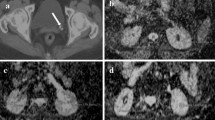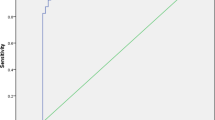Abstract
Objectives
To evaluate the kidneys of patients with haemolytic uraemic syndrome (HUS) using diffusion-weighted imaging (DWI) and Doppler ultrasound (US) compared with healthy controls.
Materials and Methods
Fifteen patients (mean age 33.3 years; three male; 12 female) with diarrhoea-positive HUS and 15 healthy volunteers were prospectively evaluated with DWI and Doppler US. A total apparent diffusion coefficient (ADCTOT), and ADCs predominantly reflecting microperfusion (ADCLOW) and diffusion (ADCHIGH) were calculated. Doppler US evaluated renal vascularity and flow.
Results
When compared with controls, kidneys affected by HUS showed reduced cortical ADC values (ADCTOT 1.79±0.22 vs. 2.04±0.1x10-3 mm2/s, P 0.001), resulting in either low corticomedullary differences (11/15 patients) or an inverted corticomedullary pattern (4/15 patients). Reduction of cortical ADC values was associated with a decrease of cortical vascularity on Doppler US (ADCTOT, P<0.001; ADCLOW, P 0.047). Kidneys with complete absence of the cortical vasculature on Doppler US (four patients) also demonstrated limited diffusion (ADCHIGH, P 0.002). Low glomerular filtration rate, requirement for haemodialysis during hospitalization, and longer duration of haemodialysis were associated with decreased cortical diffusivity (ADCTOT: P 0.04, 0.007, and <0.001, respectively).
Conclusion
DWI shows qualitative and quantitative abnormalities in kidneys affected by HUS, thereby extending the non-invasive assessment of renal parenchymal damage.
Key Points
• In HUS, DWI is feasible for functional characterization of kidney involvement.
• Kidneys affected by HUS showed reduced cortical diffusivity.
• Decreased cortical diffusivity was associated with lower kidney function.
• Requirement and duration of haemodialysis was linked to degree of cortical alterations.





Similar content being viewed by others
References
Karpac CA, Li X, Terrell DR et al (2008) Sporadic bloody diarrhoea-associated thrombotic thrombocytopenic purpura-haemolytic uraemic syndrome: an adult and paediatric comparison. Br J Haematol 141:696–707
Tostivint I, Mougenot B, Flahault A et al (2002) Adult haemolytic and uraemic syndrome: causes and prognostic factors in the last decade. Nephrol Dial Transplant 17:1228–1234
Zimmerhackl LB, Besbas N, Jungraithmayr T et al (2006) Epidemiology, clinical presentation, and pathophysiology of atypical and recurrent hemolytic uremic syndrome. Semin Thromb Hemost 32:113–120
Loos S, Ahlenstiel T, Kranz B et al (2012) An outbreak of Shiga toxin-producing Escherichia coli O104:H4 hemolytic uremic syndrome in Germany: presentation and short-term outcome in children. Clin Infect Dis 55:753–759
Buchholz U, Bernard H, Werber D et al (2011) German outbreak of Escherichia coli O104:H4 associated with sprouts. N Engl J Med 365:1763–1770
Ducker C, Dautel P, Wagner K et al (2011) Clinical symptoms, treatment and outcome of EHEC and EHEC-HUS patients treated as in-patients. Dtsch Med Wochenschr 136:1770–1776
Garg AX, Suri RS, Barrowman N et al (2003) Long-term renal prognosis of diarrhea-associated hemolytic uremic syndrome: a systematic review, meta-analysis, and meta-regression. JAMA 290:1360–1370
Colic E, Dieperink H, Titlestad K, Tepel M (2011) Management of an acute outbreak of diarrhoea-associated haemolytic uraemic syndrome with early plasma exchange in adults from southern Denmark: an observational study. Lancet 378:1089–1093
Lapeyraque AL, Malina M, Fremeaux-Bacchi V et al (2011) Complement Blockade in Severe Shiga-Toxin-Associated HUS. N Engl J Med. doi:10.1056/NEJMc1100859
Laszik ZGS, Fred G (2007) Hepinstall's Pathology of the Kidney, 6th Edition, 6th Edition edn. Lippincott Williams & Wilkins, Philadelphia
Lemmer A, Bergmann K, Walch R, Endert G (1995) Doppler ultrasound studies of long-term follow-up of children with hemolytic-uremic syndrome. Ultraschall Med 16:127–131
O'Brien JA, Van Why SK, Keller MS, Gaudio KM, Kennedy TL, Siegel NJ (1994) Altered renovascular resistance after spontaneous recovery from hemolytic uremic syndrome. Yale J Biol Med 67:1–14
Gleeson FV, Fitzpatrick MM, Somers J, Kennedy C, De Bruyn R, Barratt TM (1992) Duplex Doppler ultrasound in the investigation of occult nephropathy following haemolytic uraemic syndrome. Br J Radiol 65:137–139
Scholbach TM (2001) Changes of renal flow volume in the hemolytic-uremic syndrome--color Doppler sonographic investigations. Pediatr Nephrol 16:644–647
Glatstein M, Miller E, Garcia-Bournissen F, Scolnik D (2010) Timing and utility of ultrasound in diarrhea-associated hemolytic uremic syndrome: 7-year experience of a large tertiary care hospital. Clin Pediatr (Phila) 49:418–421
Patriquin HB, O'Regan S, Robitaille P, Paltiel H (1989) Hemolytic-uremic syndrome: intrarenal arterial Doppler patterns as a useful guide to therapy. Radiology 172:625–628
Reising A, Hafer C, Hiss M et al (2016) Ultrasound findings in EHEC-associated hemolytic-uremic syndrome and their clinical relevance. Int Urol Nephrol 48:561–570
Naesens M, Heylen L, Lerut E et al (2013) Intrarenal resistive index after renal transplantation. N Engl J Med 369:1797–1806
Boddi M, Natucci F, Ciani E (2015) The internist and the renal resistive index: truths and doubts. Intern Emerg Med 10:893–905
Thoeny HC, De Keyzer F, Oyen RH, Peeters RR (2005) Diffusion-weighted MR imaging of kidneys in healthy volunteers and patients with parenchymal diseases: initial experience. Radiology 235:911–917
Thoeny HC, De Keyzer F (2011) Diffusion-weighted MR imaging of native and transplanted kidneys. Radiology 259:25–38
Thoeny HC, Zumstein D, Simon-Zoula S et al (2006) Functional evaluation of transplanted kidneys with diffusion-weighted and BOLD MR imaging: initial experience. Radiology 241:812–821
Vermoolen MA, Kwee TC, Nievelstein RA (2012) Apparent diffusion coefficient measurements in the differentiation between benign and malignant lesions: a systematic review. Insights Imaging 3:395–409
Lassel EA, Rao R, Schwenke C, Schoenberg SO, Michaely HJ (2014) Diffusion-weighted imaging of focal renal lesions: a meta-analysis. Eur Radiol 24:241–249
Dale BM, Braithwaite AC, Boll DT, Merkle EM Field strength and diffusion encoding technique affect the apparent diffusion coefficient measurements in diffusion-weighted imaging of the abdomen. Invest Radiol 45: 104-108
Yildirim E, Kirbas I, Teksam M, Karadeli E, Gullu H, Ozer I (2008) Diffusion-weighted MR imaging of kidneys in renal artery stenosis. Eur J Radiol 65:148–153
Xu Y, Wang X, Jiang X (2007) Relationship between the renal apparent diffusion coefficient and glomerular filtration rate: preliminary experience. J Magn Reson Imaging 26:678–681
Namimoto T, Yamashita Y, Mitsuzaki K, Nakayama Y, Tang Y, Takahashi M (1999) Measurement of the apparent diffusion coefficient in diffuse renal disease by diffusion-weighted echo-planar MR imaging. J Magn Reson Imaging 9:832–837
Le Bihan D, Breton E, Lallemand D, Aubin ML, Vignaud J, Laval-Jeantet M (1988) Separation of diffusion and perfusion in intravoxel incoherent motion MR imaging. Radiology 168:497–505
Kettritz U, Semelka RC, Brown ED, Sharp TJ, Lawing WL, Colindres RE (1996) MR findings in diffuse renal parenchymal disease. J Magn Reson Imaging 6:136–144
Cheong B, Muthupillai R, Rubin MF, Flamm SD (2007) Normal values for renal length and volume as measured by magnetic resonance imaging. Clin J Am Soc Nephrol 2:38–45
Helenon O, el Rody F, Correas JM et al (1995) Color Doppler US of renovascular disease in native kidneys. Radiographics 15:833–854, discussion 854-865
Trillaud H, Merville P, Tran Le Linh P, Palussiere J, Potaux L, Grenier N (1998) Color Doppler sonography in early renal transplantation follow-up: resistive index measurements versus power Doppler sonography. AJR Am J Roentgenol 171:1611–1615
Martinoli C, Crespi G, Bertolotto M et al (1996) Interlobular vasculature in renal transplants: a power Doppler US study with MR correlation. Radiology 200:111–117
Noris M, Remuzzi G (2005) Hemolytic uremic syndrome. J Am Soc Nephrol 16:1035–1050
Tublin ME, Bude RO, Platt JF (2003) Review. The resistive index in renal Doppler sonography: where do we stand? AJR Am J Roentgenol 180:885–892
Argyle JC, Hogg RJ, Pysher TJ, Silva FG, Siegler RL (1990) A clinicopathological study of 24 children with hemolytic uremic syndrome. A report of the Southwest Pediatric Nephrology Study Group. Pediatr Nephrol 4:52–58
Keir L, Coward RJ (2011) Advances in our understanding of the pathogenesis of glomerular thrombotic microangiopathy. Pediatr Nephrol 26:523–533
Sigmund EE, Vivier PH, Sui D et al (2012) Intravoxel Incoherent Motion and Diffusion-Tensor Imaging in Renal Tissue under Hydration and Furosemide Flow Challenges. Radiology 263:758–769
Emre T, Kilickesmez O, Buker A, Inal BB, Dogan H, Ecder T (2016) Renal function and diffusion-weighted imaging: a new method to diagnose kidney failure before losing half function. Radiol Med 121:163–172
Xu X, Fang W, Ling H, Chai W, Chen K (2009) Diffusion-weighted MR imaging of kidneys in patients with chronic kidney disease: initial study. Eur Radiol 20:978–983
Le Bihan D, Breton E, Lallemand D, Grenier P, Cabanis E, Laval-Jeantet M (1986) MR imaging of intravoxel incoherent motions: application to diffusion and perfusion in neurologic disorders. Radiology 161:401–407
Koh DM, Collins DJ (2007) Diffusion-weighted MRI in the body: applications and challenges in oncology. AJR Am J Roentgenol 188:1622–1635
Liang L, Chen WB, Chan KW et al (2016) Using intravoxel incoherent motion MR imaging to study the renal pathophysiological process of contrast-induced acute kidney injury in rats: Comparison with conventional DWI and arterial spin labelling. Eur Radiol 26:1597–1605
Levey AS, Coresh J, Greene T et al (2006) Using standardized serum creatinine values in the modification of diet in renal disease study equation for estimating glomerular filtration rate. Ann Intern Med 145:247–254
Levey AS, Coresh J, Greene T et al (2007) Expressing the Modification of Diet in Renal Disease Study equation for estimating glomerular filtration rate with standardized serum creatinine values. Clin Chem 53:766–772
Author information
Authors and Affiliations
Corresponding author
Ethics declarations
Guarantor
The scientific guarantor of this publication is PD Dr. J. Herrmann.
Conflict of interest
The authors of this manuscript declare relationships with the following companies: Michaela Joekel, Siemens AG Healthcare, Hamburg, Germany.
Funding
The authors state that this work has not received any funding.
Statistics and biometry
Two of the authors (Kay U. Petersen and Michael Groth) have significant statistical expertise.
Ethical approval
Institutional Review Board approval was obtained.
Informed consent
Written informed consent was obtained from all subjects (patients and controls) in this study.
Study subjects or cohorts overlap
No study subjects or cohorts have been previously reported.
Methodology
•prospective
•case-control study
•performed at one institution
Electronic supplementary material
Below is the link to the electronic supplementary material.
Supplemental Material Fig. 6
(DOC 25 kb)
Supplemental Material Fig. 7
(DOC 25 kb)
Supplemental Material Fig. 8
(DOC 25 kb)
Rights and permissions
About this article
Cite this article
Herrmann, J., Wenzel, U., Galler, S. et al. Diffusion-weighted imaging of the kidneys in haemolytic uraemic syndrome. Eur Radiol 27, 4591–4601 (2017). https://doi.org/10.1007/s00330-017-4848-2
Received:
Revised:
Accepted:
Published:
Issue Date:
DOI: https://doi.org/10.1007/s00330-017-4848-2




